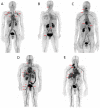Immuno-PET for Clinical Theranostic Approaches
- PMID: 28036044
- PMCID: PMC5297692
- DOI: 10.3390/ijms18010057
Immuno-PET for Clinical Theranostic Approaches
Abstract
Recent advances in molecular characterization of tumors have allowed identification of new molecular targets on tumor cells or biomarkers. In medical practice, the identification of these biomarkers slowly but surely becomes a prerequisite before any treatment decision, leading to the concept of personalized medicine. Immuno-positron emission tomography (PET) fits perfectly with this approach. Indeed, monoclonal antibodies (mAbs) labelled with radionuclides represent promising probes for theranostic approaches, offering a non-invasive solution to assess in vivo target expression and distribution. Immuno-PET can potentially provide useful information for patient risk stratification, diagnosis, selection of targeted therapies, evaluation of response to therapy, prediction of adverse effects or for titrating doses for radioimmunotherapy. This paper reviews some aspects and recent developments in labelling methods, biological targets, and clinical data of some novel PET radiopharmaceuticals.
Keywords: antibody; immuno-PET; molecular imaging.
Conflict of interest statement
The authors declare no conflict of interest.
Figures


References
-
- Mellstedt H. Monoclonal antibodies in human cancer. Drugs Today. 2003;39:1–16. - PubMed
Publication types
MeSH terms
Substances
LinkOut - more resources
Full Text Sources
Other Literature Sources

